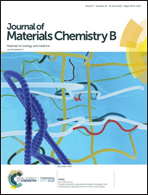Minocycline hydrochloride loaded graphene oxide enables enhanced osteogenic activity in the presence of Gram-positive bacteria, Staphylococcus aureus
Abstract
Implant failures still happen because of bacterial infections and inferior osteogenic properties. Graphene oxide (GO) could induce osteogenic differentiation as well as exhibit superior antibacterial activity which may provide an answer for this issue. In this work, GO films loaded with minocycline hydrochloride (MH) were fabricated on titanium implant surfaces, and the antibacterial activity and osteogenic properties were studied in the presence of S. aureus and rat bone mesenchymal stem cells (rBMSCs) in in vitro and in vivo environments, respectively. The results indicated that the MH loaded GO films on titanium surfaces (MH&GO@Ti) exhibited enhanced osteogenic activity in vitro with improved alkaline phosphatase (ALP) activity and enhanced osteogenic related gene expressions including ALP, collagen-I, osteocalcin, and osteopontin. The in vitro results of the co-culture of rBMSCs and S. aureus indicated that the rBMSCs grew well on the MH&GO@Ti sample with a higher coverage of cells and the bacteria were almost unobservable on the surface. In the in vivo experiments, the MH&GO@Ti exhibited excellent antibacterial and osteogenic activities in the presence of bacteria. No inflammatory cells for example neutrophils were found and superior bone–implant integration was obtained. This study offers a new proposal for the clinical application of drug-loaded graphene coating.



 Please wait while we load your content...
Please wait while we load your content...